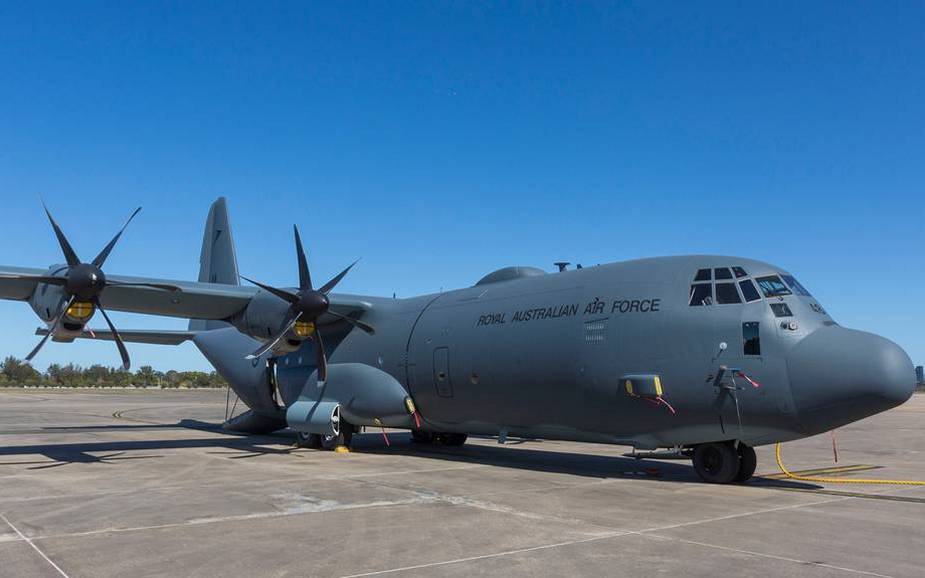On November 2, 2022, the U.S. State Department made a determination approving a Foreign Military Sale to the Government of Australia of Lockheed Martin C-130J-30 aircraft and related equipment for an estimated cost of $6.35 billion. The Defense Security Cooperation Agency delivered the required certification notifying Congress of this sale. So, the Royal Australian Air Force (RAAF) will be replacing its current fleet of 12 Lockheed Martin C-130J Super Hercules tactical transport aircraft as part of efforts to improve mobility capabilities.
Follow Air Recognition on Google News at this link
 RAAF C-130J Super Hercules (Picture source: Commonwealth of Australia)
RAAF C-130J Super Hercules (Picture source: Commonwealth of Australia)
The Government of Australia has requested to buy twenty-four (24) C-130J-30 aircraft with four (4) each Rolls Royce AE-2100D turboprop engines installed; twenty-four (24) Rolls Royce AE-2100D turboprop engines with Quick Engine Change Assembly (QECA) and propellers installed (spares); sixty (60) Embedded Global Positioning System/Inertial Navigation System (GPS/INS) (EGI) security devices, airborne (48 installed, 12 spares); thirty-two (32) AN/ALQ-251 Radio Frequency Countermeasure (RFCM) systems; twenty-seven (27) Guardian Laser Transmitter Assemblies (GLTA) for Large Aircraft Infrared Countermeasures (LAIRCM) systems (24 installed, 3 spares); sixteen (16) AN/AAQ 24(V)N LAIRCM System Processor Replacements (LSPR) (12 installed, 4 spares); and twenty-four (24) Multifunctional Information Distribution System Joint Tactical Radio System (MIDS JTRS) (installed). Also included are AN/AAQ 24(V)N LAIRCM Infrared Missile Warning Sensors (MWS), Control Interface Unit Replacements (CIRU), and classified memory card User Data Modules (UDM); KYV-5M communication security modules; AN/ARC-190 High Frequency (HF) radios; AN/ARC-210 radios; AN/ARN-153 tactical airborne navigation (TACAN) systems; AN/ARN-147 receivers; AN/ARN-149(V) automatic direction finders; AN/APX-119 Identification Friend or Foe (IFF) transponders; AN/AAR 47 missile warning systems; AN/APN-241 Low-Power Color Radars (LPCR); AN/ALE-47 Countermeasures Dispensing Systems (CMDS); AN/ALR-56 Radar Warning Receivers (RWR); AN/PYQ-10 Simple Key Loaders; MX-20HD electro optical/infrared targeting systems; AN/KIV-77 IFF cryptographic appliques; Advanced Digital Antenna Production (ADAP) system components; integration support and test equipment; aircraft and support equipment; secure communications equipment, precision navigation, and cryptographic devices; classified software delivery and support; spare and repair parts, consumables and accessories; maintenance and maintenance support; classified manuals, publications, and technical documentation; personnel training and training equipment, and U.S. Government and contractor engineering, technical and logistics support services, studies and surveys; and other related elements of logistical and program support. The estimated total cost is $6.35 billion.
This sale will improve Australia’s capability to meet current and future threats by providing the Royal Australian Air Force (RAAF) with replacements for its 12 aging C-130J fleet: the RAAF’s C-130J Super Hercules first entered service in 1999 to replace the C-130H. The principal contractor will be Lockheed Martin Corporation, Marietta, GA. Implementation of this proposed sale will not require the assignment of any additional U.S. Government or contractor representatives to Australia.
The Airbus A400M was offered but Australia finds it risky to shift to the larger aircraft considering the RAAF has been flying Hercules since the late 1950s with the legacy C-130A. Indeed, prior to operating the C-130J Super Hercules, the RAAF has been operating legacy Hercules variants since 1958 with the C-130A, C-130E, and C-130H.
















